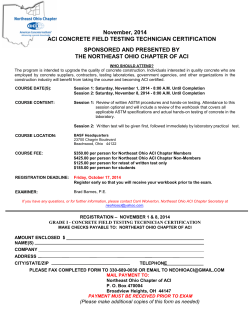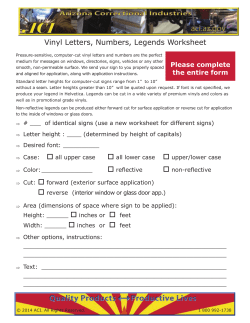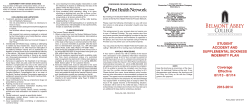
(UAS) Terrestrial C2 Frequency
ACP WG-F/31 WP08 Unmanned Aircraft System (UAS) Terrestrial C2 Frequency-Planning Activities in RTCA SC-228 Frank Box, Alexe Leu, and Leo Globus 22 September 2014 1 C-Band Terrestrial Frequency Planning • • • • • • Characteristics of Strawman C2 System Coexistence Rules for Terrestrial C2 Links Channelization Planning Very-High-Altitude UAS Coexistence with UAS C2 SATCOM Appendix: Sample Link Budgets 2 System Design Constraints • Available frequency bands: – L-band (960–1164 MHz) – C-band (5030–5091 MHz) • Maximum UA transmitter power per band for basic service: 10 watts • Required availability (per band) = 99.8% • Maximum UA groundspeed = 850 knots • Frequency instability: 1.0 ppm or better • Transmitter mask: GMSK (BT = 0.2) or comparable • Time-division duplexing – Synchronized among all users 3 Link Throughput Requirements Service Class 1 2 3 4 Services Provided: Basic Telecommand and Telemetry ATC voice and ATS data relay Navaid and Detect-and-Avoid Data Video* and Airborne Wx Radar Data Required Throughput (kbps): Uplink (automatic UA operation) 1.242 6.091 6.230 6.230 Downlink (automatic UA operation) 1.272 6.131 11.163 308.933 Uplink (manual UA operation) 4.593 9.442 10.108 10.108 Downlink (manual UA operation) 7.595 12.454 18.391 316.161 * These video links (for takeoff, landing, taxiing) would each carry 217 kbps plus overhead. A need for a single nationwide emergency video channel that would use 435 kbps (plus overhead) has also recently been identified but is not considered in the above table. 4 Strawman System Configurations Configuration Information Rate (kbps) Symbol Rate (kbaud) Standalone telecommand uplink or basic telemetry downlink 14.80 87.5 Medium-throughput downlink 35.28 150 Networked TDMA uplink with 4 slots 28.48 200 Networked TDMA uplink with 8 slots 56.96 400 Networked TDMA uplink with 12 slots 85.44 600 High-throughput (video-capable) downlink 237.52 750 Networked TDMA uplink with 16 slots 113.92 800 Networked TDMA uplink with 20 slots 142.40 1000 System design is under review to improve spectral efficiency by: • Providing additional configurations with smaller information rates • Finding ways to reduce symbol rates for all configurations 5 3-D Cellular Frequency Plan 1/12 frequency reuse Highest altitude tier (50 kft) 1/3 frequency reuse (better) Lowest altitude tier (surface) INTERMEDIATE TIERS NOT SHOWN • “Cells” are airspace volumes • Frequency list for each cell, assignable as needed when UA in cell – Nationwide plan to be developed • Ground stations (standalone/gapfiller) can be anywhere in a cell 6 Low-Altitude Coverage and Gapfillers Coverage down to 4000’ • Likely cell radius 69 nmi Gapfiller Down to 1000’ Down to ground • In most of cell, low-altitude UA need “gapfiller” GSs CENTRAL 100’ TOWER Gapfiller • Central ground station (GS) cannot provide coverage down to ground throughout cell Gapfiller Gapfiller • When gapfillers are far enough apart, they may be able to share frequencies in same cell Gapfiller CELL BOUNDARY 69 NAUTICAL MILES 7 Examples of Potential Adjacent-Channel Interference (ACI) between Cells VICTIM UA DESIRED UPLINK POTENTIALLY INTERFERING GS VICTIM GS DESIRED GS • • • • • Uplink-to-uplink ACI scenario Desired GS and interferer on (first) adjacent channels Victim UA at edge of its cell Both UA have omni antennas Potential interferer must limit power radiated toward cell boundary Adequate adjacent-channel rejection (ACR) also needed to prevent ACI POTENTIALLY INTERFERING UA DESIRED DOWNLINK Downlink-to-downlink ACI worst case • Desired UA and interferer are: – On first adjacent channels – Roughly equidistant from victim GS – Both in victim GS’s main beam • • Both UA have omni antennas Here, ACR may be victim GS’s only protection against ACI 8 Intersite Coexistence Rules (1 of 2) • Interference prevention between cells – Power flux density (PFD) limits, in dBm/m2, at cell boundaries • Interference prevention within cells – Single-transmitter radiation limits – EIRP limits – Frequency-sharing rules for “gapfiller” and standalone ground stations • PFD, radiated-power, and EIRP limits will: – Be different for uplinks and downlinks – Depend on channel symbol rate (kbaud) 9 Intersite Coexistence Rules (2 of 2) • Free-space PFD at cell edge shouldn’t exceed what the potentially interfering link would need for good availability if its own receiver were there • In some scenarios, only protection against ACI is to ensure that ACR is large enough to provide link margin needed to allow for multipath, etc. – Ground-antenna diversity (if affordable) would reduce ACR requirements – C2 channel spacings must be set large enough to ensure adequate ACR • Although ACR is main threat, cochannel PFD limits also needed for very-high-altitude UA with very long radio lines of sight 10 Channelization Planning Decision Tree A Required Throughput Necessary Overhead Symbol Rate (e.g., 87.5 kbaud) Modulation (GMSK, BT = 0.2?) Transmitter Mask Channels Needed per Cell (20?) Min. Acceptable Freq. Reuse, 1/K (1/12?) Max. UA Ground Speed (850 kn) Required Availability (99.8%) Freq. Stability Receiver Mask (1 ppm) Frequency-Dependent Rejection Curve Max. Radio-Horizon Distance (261 nmi?) Channel Spacing for Given Symbol Rate (45,000 feet?) Cell Radius (69 nmi?) Max. GS Distance from Cell Edge (69 nmi?) Necessary Multipath/ Rain/Airframe Loss Margin Necessary AdjacentChannel Rejection (ACR) Max. Cell Altitude Min. UA Altitude at Cell Edge (4000 feet?) Diversity Assumptions Max. UA Transmitter Power (40 dBm) UA SWAP Constraints Necessary Ground-Antenna Gain (L-band: 19 dBi? C-band: 38 dBi?) Number of Channels Available Necessary Ground-Antenna Aperture A (L-band: 1 m2? C:-band: 3 m2?) 11 How Much ACR Is Necessary? • Ensure, through GS power/pointing/location restrictions, that at cell boundaries (the worst case) free-space interference power flux density (PFD) will not exceed free-space signal PFD • Design link budgets to allow received interference power (after filtering) to equal receiver noise power (INR = 0 dB) – Sample C-band link budgets shown in Appendix A • Then the minimum ACR sufficient to allow 99.8% availability in the presence of potential ACI from an adjoining cell can be calculated as: Parameter L-band C-band 29.6* 33.6* Required Eb/N0 (dB) 2.5 2.5 Implementation margin (dB) 1.0 1.0 Allowance (dB) for interference = noise 3.0 3.0 Total (minimum required ACR in dB) 36* 40* Worst-case 99.8%-availability link margin (dB) needed for multipath/rain/airframe losses * Assumes dual airborne-antenna diversity but no ground diversity. Using dual or triple ground diversity could reduce necessary link margins and ACR values by 9–14 dB. 12 Strawman C-Band Masks Design assumptions: GMSK (BT = 0.2) 87.5 kbaud 850-knot Doppler shift 1.0-ppm frequency instability Attenuation (dB) 0 Transmitter Receiver 70 80 21.9 39.5 122.5 160.3 Offset from Channel Center Frequency (kHz) 13 Frequency-Dependent Rejection (FDR) of 87.5-kbaud C-band Transmitter and Receiver 70 60 FDR (dB) 50 40 30 20 10 0 0 50 100 150 Frequency Offset (kHz) 200 250 Red curve allows for Doppler shift and frequency instability 14 Channelization Goals • Spectral efficiency – Small channel spacings ( large number of channels) • ACI prevention – Spacings large enough to provide adequate ACR • Simplicity – Every channel spacing should be integer multiple of smallest spacing in band – Round numbers preferred • Harmonization – Consistency with channel spacings of other systems in band • MLS (300 kHz) • UAS C2 SATCOM (300 kHz?) • Not feasible to achieve every goal in same plan – Tradeoffs necessary; no perfect plan 15 Channelization Principles • Flexibility – Each C-band C2 radio may have full repertoire of channel spacings throughout its tuning range • No part of tuning range to be permanently tied to a single channel spacing • Channels of same size should be grouped together – Helps protect wide channels against ACI from narrow ones • Partitions between channel groups should be movable – Since relative utilization of symbol rates is unpredictable and will evolve over time • C-band needs wider channel spacings than L-band – Greater Doppler shifts and frequency instability 16 Possible C-band Channelization Plans Info Rate (kbps) Symbol Rate (kbaud) 14.80 87.5 Simple Plan (Harmonized with MLS Channelization Plan) More Spectrally-Efficient Plan (Would Support More UAS) Spacing (kHz) ACR (dB) Channels in 60 MHz Spacing (kHz) ACR (dB) Channels in 60 MHz 150 44 400 150 44 400 35.28 150 300 69 200 250 58 240 28.48 200 300 55 200 250 39 240 56.96 400 600 63 100 500 48 120 85.44 600 900 66 66 750 51 80 237.52 750 1200 68 50 1000 57 60 113.92 800 1200 67 50 1000 52 60 142.40 1000 1500 67 40 1250 53 48 NOTE: One or more smaller channel spacings (TBD) are also needed for narrowband signals. 17 Potential Cochannel Interference to and from Very-High-Altitude UA (VUA) Scenario: • VUA stays 65 kft above its GS (above highest C2 cell) • VUAS uses frequencies allocated to highest-tier cell beneath it • “Not-very-high-altitude UA” (NUA) uses same frequency as VUA • Since VUA > 50 kft AGL, K=12 cell plan allows ground/air RLOS to 6 “cochannel” cells (only one shown in picture) • Cochannel RFI (CCI) threatens VUAS uplink & NUAS downlink (VUAS downlink & NUAS uplink protected by earth curvature) VUA 65 kft NUA “Footprint” of highest-altitude tier of cells 12 7 10 8 VUAS GS 5 3 300 nmi ( 4.35 cell radii) 7 NUAS GS 18 Key Findings of VUAS Analysis • CCI to and from very-high-altitude UAS (VUAS) can be prevented by: – Assigning to each VUAS a frequency that has been allocated to the highest-tier cell beneath it – Appropriately reducing VUAS uplink and downlink transmitter powers – Using highly directional VUAS GS antennas • To protect VUAS against downlink ACI, operational procedures may be needed to keep not-very-high-altitude UA (NUA) from staying too close to VUAS GS in its main beam for too long 19 Coexistence between Terrestrial and SATCOM UAS C2 Links (1 of 2) Note: This slide and the next summarize ACP WGF28/WP13(rev1), “5GHz Band-Planning Considerations for UAS CNPC Links,” March 2013 • WRC-12 decided 5030–5091 MHz band can be shared by AMS(R)S and AM(R)S C2 links • Unless AM(R)S or AMS(R)S is absent in a given region, putting AM(R)S in center of band and AMS(R)S at high and low ends would have these advantages: – If AMS(R)S uses frequency-division duplexing, it needs to maximize frequency separation between Earth space and space Earth segments, because of filter-design constraints – Radio Regulations footnote 5.443C limits AM(R)S EIRP density to –75 dBW/MHz in the 5010–5030 MHz band, so large separation between that band and the AM(R)S segment would be useful 20 Coexistence between Terrestrial and SATCOM UAS C2 Links (2 of 2) • If band is partitioned between AM(R)S and AMS(R)S, boundaries between segments should be movable – Protects against having to make premature, binding decisions on relative terrestrial and SATCOM allocations • Boundary adjustments would be made infrequently based on capacity demand patterns – Allows for the possibility that some regions might use only one of the two types of 5-GHz link (terrestrial or SATCOM, but not both) – Allows common wideband RF filter (over the entire 5030– 5091 MHz band) that would be: • Simpler to implement than narrowband filters • Usable by hybrid terrestrial/SATCOM terminals 21 Next Steps • • • • • • • Refine terrestrial C2 system design Firm up necessary data and symbol rates Redesign masks and recompute FDR curves Develop firm list of channel spacings for each band Recommend specific channel placements Develop nationwide channel plan Develop dynamic frequency-assignment procedures 22 Appendix: Sample C-Band Uplink Budgets 23 Sample C-Band Uplink Budgets Parameter Frequency Symbol Units Values Notes f MHz 5060 5060 Pex = Pt + Gt - Lct Aircraft altitude, AGL Ha ft 18000 4000 Pe = Pex - Lpt Ground-antenna height Ht ft 100 100 Dpf = Pe - 20 log d - 10 log (4p*1852^2) = Pe - 20 log d - 76.345 Lf = 20 log f + 20 log d + 37.8 Path distance d nmi 71 71 Symbol rate Rs kbaud 87.5 87.5 Transmitter power Pt dBm 40.0 40.0 Eb/N0 = 2.5 dB for GMSK with BT = 0.2 Maximum transmitting-antenna gain Gt dBi 38.0 38.0 Bn assumed equal to Rs Transmitter cable loss Lct dB 1.0 1.0 N = Nt + 10 log Bn + Fn Maximum EIRP Pex dBm 77.0 77.0 Transmitting-antenna pointing loss Lpt dB 2.0 2.0 Prm = Pe - Lf + Gr - Lcr Dual airborne-antenna diversity assumed, but not ground diversity La obtained from SC203-CC016 data for 2.4-GHz signal EIRP toward receiver Pe dBm 75.0 75.0 Free-space value of received signal PFD Dpf dBm/m2 -38.4 -38.4 Lx based on ITU-R Recs. P.530-11, P. 618-9, P.838, P.676-6, and P.840-3 Free-space path loss Lf dB 148.9 148.9 Mc = sqrt ((La + Va)^2 + Lx^2 + Mb^2) -- approximation in lieu of convolution Mean receiving-antenna gain Gr dBi 2.0 2.0 M = Mm + Mc + Mi + Ma Prq = Eb/N0 + N + M Receiver cable loss Lcr dB Mean received signal power Prm dBm Eb/N0 dB Required signal-to-noise ratio per bit 2.0 2.0 -73.9 -73.9 2.5 2.5 dBm/kHz -144.0 -144.0 Thermal-noise spectral power density Nt Noise bandwidth of receiver Bn kHz 87.5 87.5 Receiver noise figure Total receiver noise Fn N dB dBm 4.0 -120.6 4.0 -120.6 Implementation margin Mm dB 1.0 1.0 Airframe loss value for CDF = 0.002 La dB 20.0 20.0 Est. variation from 2.4-GHz airframe loss Va dB 2.0 2.0 Excess path-loss value for CDF = 0.002 Lx dB 16.4 24.7 RFI multipath boost for CDF = 0.002 Mb dB 6.0 6.0 Combined airframe/path/RFI margin Mc dB 28.1 33.6 Allowance for interference = noise Mi dB 3.0 3.0 Aviation safety margin Total required margin for 99.8% avail. Ma M dB dB 6.0 38.1 6.0 43.6 Required signal power Prq dBm -80.0 -74.5 Excess margin Mx dB 6.1 0.6 Va estimated by assuming airframe loss increases from S- to C-band Mx = Prm - Prq 24 24
© Copyright 2025











